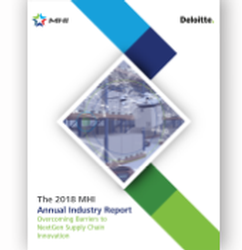
MHI releases 2018 Annual Industry Report
MHI just released the 2018 MHI Annual Industry Report titled “Overcoming Barriers to NextGen Supply Chain Adoption” to provide an up-to-date perspective on emerging supply chain trends.
Key findings include:
- Eleven technologies are working together to create next-generation supply chains that are digital, on-demand and always-on. Eight out of ten survey respondents believe these supply chains will be the predominant model within just 5 years.
- The top technologies respondents say can be a source of either disruption or competitive advantage are:
• Robotics and automation (65 percent, up from 61 percent in 2017)
• Predictive analytics (62 percent, up from 57 percent in 2017)
• The Internet-of-Things (IoT) (59 percent, up from 55 percent in 2017)
• Artificial Intelligence (53 percent, new category in 2018)
• Driverless vehicles & drones (52 percent, up from 30 percent in 2015) - The top three barriers to adoption of these technologies are:
• Making the business case for NextGen supply chain investments
• Tackling the supply chain skills gap and workforce shortage
• Building trust and security in digital, always-on supply chains - When it comes to cybersecurity, the sophistication of hackers and “threat actors” is the biggest risk (44 percent), followed by the lack of awareness of the threat within the organization (40 percent) and poor cybersecurity practices among suppliers (37 percent). As cybersecurity concerns grow, the demand for transparency at every level of the supply chain is skyrocketing as consumers increasingly expect full information about the origin and history of the products they consume.
Blockchain’s unparalleled ability to enable transparent yet controlled data sharing in a way that is extremely reliable, efficient, and highly-encrypted provides a powerful and robust platform to tackle some of today’s toughest supply chain challenges, while also providing an unmatched level of cybersecurity. This is where blockchain can be a huge supply chain differentiator.
The findings in this report are based on survey responses from 1,100 manufacturing and supply chain industry leaders from a wide range of industries. Half of respondents hold executive-level positions such as CEO, Vice President, General Manager, or Department Head. Participating companies range in size from small to large, with 47 percent reporting annual sales in excess of $100 million, and 10 percent reporting annual sales of $10 billion or more.









